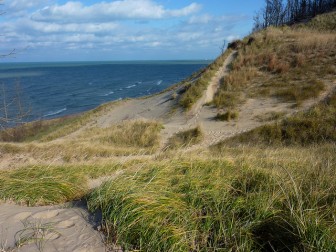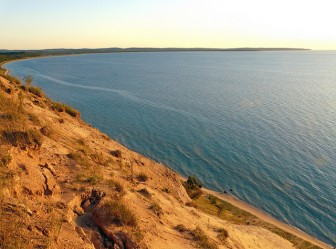By Eric Freedman

A look at the region’s national parks during centennial
Some draw more than a million visitors each year, others only a fraction of that number.
Some sprawl over wide expanses, others cover less than a few acres.
Some boast internationally recognizable names, others fall outside the public spotlight.
They’re Great Lakes region units of the National Park Service (NPS), which celebrates its centennial this year. Popular or not, vast or small, widely familiar or not, they’re publicly owned treasures of environmental and natural resources, historic and cultural wealth, recreation and national identity.

A view of the beach below a dune from the Indiana Dunes National Lakeshore. Image: carfull…
To commemorate the 1916 creation of the National Parks Service, Great Lakes Echo will report throughout the year on news about parks, monuments, lakeshores, historic sites and other units in the eight Great Lakes States. Coverage will include events, research and controversies.
We welcome story ideas from our readers. Email them to GreatLakesEcho@gmail.com.
While the system has its origins in an 1872 law creating Yellowstone National Park, Congress waited until 1916 and Woodrow Wilson’s presidency to establish the NPS. The system now encompasses 409 units with more than 84 million acres. Collectively, they drew about 280 million visitors in 2014.
In the Great Lakes region, the best-known include Isle Royale National Park in Michigan, Indiana Dunes National Lakeshore in Indiana, Voyageurs National Park in Minnesota, Apostle Islands National Lakeshore in Wisconsin, stretches of the Appalachian National Scenic Trail in New York and the North Country Scenic Trail in Pennsylvania, Cuyahoga Valley National Park in Ohio and Pullman National Monument in Chicago.

Waterfall near Todd Harbor at Isle Royale National Park. Image: Ray Dumas
Cuyahoga Valley hosted roughly 2.3 million recreational visitors last year, Michigan’s Sleeping Bear Dunes National Lakeshore 1.5 million and Indiana Dunes 1.6 million.
Others are far less-known and less-visited.
For example, River Raisin National Battlefield Park in Michigan drew about 109 recreational visitors in 2015, the Dayton Aviation Heritage National Historic Park in Ohio drew more than 73,000 and the Theodore Roosevelt Inaugural National Historic Site in New York drew about 25,000, NPS preliminary figures show.
While the largest unit in the system covers 13.2 million acres in Alaska, the Great Lakes region is home to the smallest: the David Berger National Memorial is a few square yards in size in Beachwood, a Cleveland suburb. It’s a sculpture commemorating a U.S.-Israeli weightlifter who was among 11 Israeli athletes murdered in a Palestinian terrorist attack at the 1972 Olympics in Munich, Germany.
The Washington-based National Parks Foundation says it’s important “to ensure that the centennial is more than a birthday. We want people everywhere to embrace the opportunities to explore, learn, be inspired or simply have fun in their 407 national parks, as well as understand how the National Park Service’s community-based recreation, conservation and historic preservation programs positively impact their own communities.”
In the Great Lakes region, NPS units already have scheduled many commemorative events.
The centennial “is a big deal for us,” said Jo Holt, the historian at Keweenaw National Historic Park in Michigan’s Upper Peninsula.
Centennial events will be part of such activities as the annual CopperDog 150 sled dog race that starts and ends in the park and the National Public Lands Day annual bicycling tour, she said.
At Minnesota’s Grand Portage National Monument, Superintendent Tim Cochrane said, “Perhaps the biggest deal for us this year is hosting one Tall Ship here during our largest special event, Rendezvous Days,” coinciding with the Grand Portage Band’s annual Pow Wow that attracts hundreds of fur trade reenactors and more than 600 dancers from across the Upper Midwest and central Canada.
Indiana Dunes has scheduled a Music Heritage Series with “traditional music associated with the Ragtime and Jazz eras, World War I and patriotism” of 1916 and a free celebratory concert by the Northwest Indiana Symphony. The national lakeshore will also host a “50 years of photography in the Indiana Dunes” exhibition to mark its own golden anniversary.
Plans at Apostle Islands include an open house at the Bayfield Visitor Center during National Park Week, a Centennial Bio Blitz on on the mainland to help ensure everyone who wants to participate can do so and a centennial theme for the annual Bayfield Apple Festival, according to the park’s Chris Smith.

Southwest view from Treat Farm Dunes at Sleeping Bear Dunes National Lakeshore. Image: jimflix!
Sleeping Bear Dunes will mark the centennial and “highlight the value of national parks as our nation’s ‘living laboratories’ with a series of monthly public talks by park researchers. Topics for the “Research Rendezvous” series include “Natural History of Bats in Michigan,” “Hibernation of Bats and White-nose Syndrome,” “Comparison of Coastal Landforms and Sediments between Sleeping Bear Dunes and Indiana Dunes National Lakeshores,” “Investigating the Importance of Deer for Lyme Disease Ecology: a Natural Experiment Presented by Lake Michigan Islands” and “Avian Botulism in Lake Michigan: How Does it Happen?”
And at Perry’s Victory and International Peace Memorial on Lake Erie in Ohio, Ranger Jeff Helmer said there’ll be a centennial component to all the park’s 2016 events, including its Mayfly Festival and the annual celebration of Commodore Oliver Perry’s birthday. Perry led the victorious U.S. naval forces on Lake Erie during the War of 1812 against Great Britain.
And sadly, what would be the greatest spring time tourist draw of all is not seen. The ice flow from Lake Erie, down the Niagara River, over the Falls and out into Lake Ontario would generate more interest, business and dollars than anything else in the world. Instead, this 12,000 year old annual cycle which is so crucial to all of the environment in the Lower Great Lakes, is stopped by an ice boom. The ever greedy New York Power Authority maximizes the profits at the expense of everything else. What’s the point of a national park if it isn’t protected from this kind of plunder? Google “Joe Barrett ice boom” and read “Ice Boom Theory “.